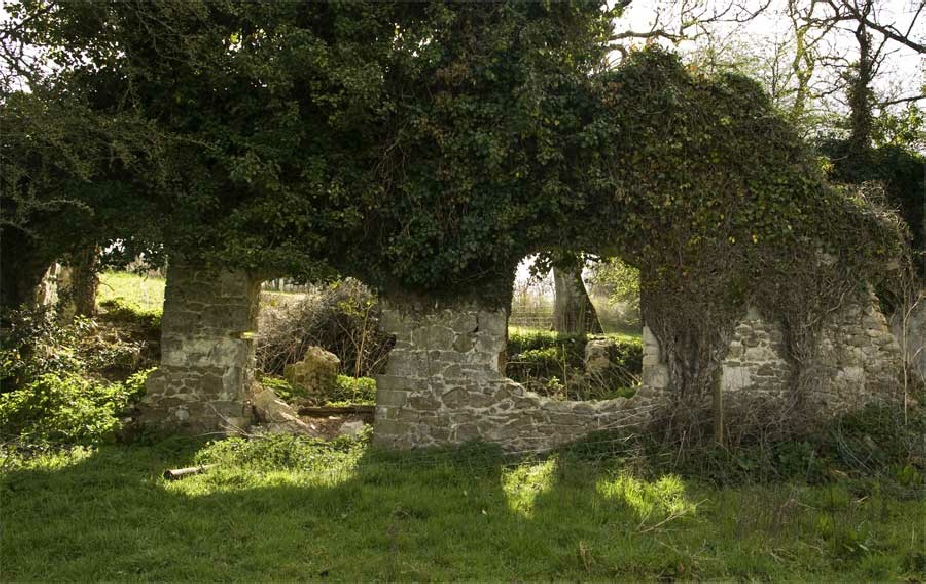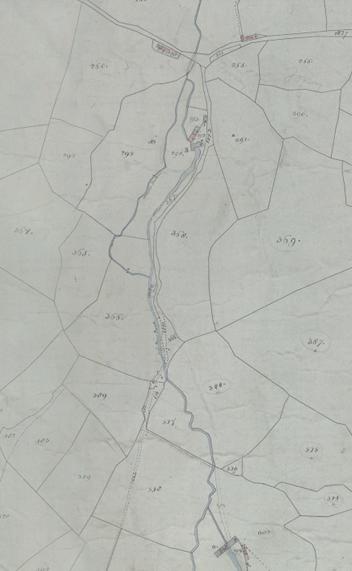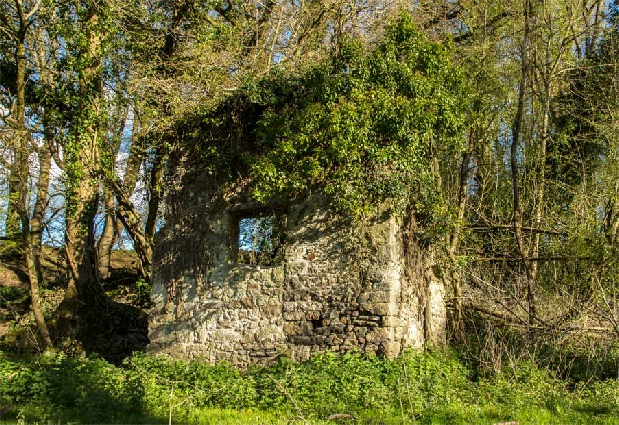


THORNCOMBE’S INDUSTRIAL RELICS
Two precious relics of Thorncombe’s industrial past still just about survive, both within easy walking distance of Thorncombe village. Hidden among the trees in the Synderford valley are two woollen factories, Chaffeigh Mill and Shedrick Mill, both of which are around 175 years old, if not more. But if you want to see them, you need to be quick as they are starting to disappear at an alarming rate.

Chaffeigh Mill (2009)© Rachael Whitbread
Evidence
Wills and other evidence dating back to 1593 tell us that Thorncombe supported a thriving colony of weavers and associated trades until well into the 19th century 1. Thorncombe parish priest Samuel Hood writing in 1767 referred to, ‘narrow cloth made in abundance … partly disposed of in our own great fair and partly sent to foreign markets by merchants’2. Thorncombe had an annual fair on Easter Tuesday. Narrow cloth was a coarse low napped woollen fabric, 36” wide used for outer garments, coats, uniforms, skirts. Unsubstantiated local hearsay has it that there was a mill at Chaffeigh as early as 1750, weaving cloth for the parish poor house. Given Chaffeigh Mill, unlike Shedrick Mill is not marked on either the 1806 or 1809 OS maps, it is possible a mill at Chaffeigh Farm predates the factory in the Synderford valley 3, 4. Chaffeigh Farm was destroyed by fire in 1962. The 1889 OS map records that Chaffeigh Mill had fallen into disuse and that the premises at Shedrick Mill were being used to manufacture bricks.
The earliest documented evidence discovered so far for Chaffeigh mill is an 1837 prosecution of Bernard Chaffey relating to offences under the 1833 Factory Act connected with the employment of children under 13. In the same publication, a return dated 1839 records three woollen mills in the parish of Thorncombe employing 50 people 5. One belonged to George Warry Berry at New House, Holditch. The parish’s 1839 Tithe Map lists two others, Chaffeigh and Shedrick manufactories, both owned by Bernard Chaffey 6 .
According to the 1839 tithe apportionment Bernard Chaffey lived at Maudlin. He apparently was an affluent pillar of the community. In 1836 as one of 21 Thorncombe’s principal inhabitants and ratepayers he signed a petition in favour of sending Thorncombe’s paupers to the Chard Union Workhouse instead of the one in Axminster 7. Nine years later in 1845, along with Colonel Bragge of Sadborow, he is listed as a founder committee member and shareholder for the Exeter Yeovil and Dorchester Railway 8.

Chaffeigh Mill (2012)© Rachael Whitbread
Prosecutions
But there is a question mark over whether Bernard Chaffey was a good employer. In 1847 he was again fined by local magistrates. This time for a total of £7 0s 0d plus £2 19s 0d costs (worth £666 today) again for offences relating to the employment of children, under the 1839 Factory Act 9. As well as not registering them, having them medically examined or sending them to school, his other offences were making children work for more than seven hours a day and between the hours of noon and 1pm 10.
The Tithe Map shows that both mills were powered by a complicated system of leats
to accumulate the water needed to drive the mill wheels. Fragments can still be
found in the undergrowth around the mills and along the road, also on the 1806 OS
map, now a bridleway, which links them. Inevitably, due to the vagaries of the weather,
there were frequent non-
Part of the 1838 Tithe Map showing Chaffeigh and Shedrick Mills and the leats in between (DHC ref: T/THO)
Reproduced by kind permission of Dorset History Centre
In 1880 a Frome resident recalled how ‘The work people were sometimes called at midnight on Sunday to use the water that had collected and they would work till 10.a.m. Monday when the water was getting low. They would start again about 5 p.m. and go on as long as there was any water. If they lived a distance they often slept in their clothes … all the girls doing such work never took their clothes off for a week’ 12.
Whether or not making minors work longer than the law permitted was an isolated incident and is evidence of child exploitation is not currently known. Given George Warry Berry was also prosecuted at the same court hearing as Bernard Chaffey, for other offences under the Factories Act, it can be implied that the inspectors swooped without warning and found children working without a lunch break at Chaffeigh Mill when they should have been at school. So it is likely that this was not an isolated misdemeanour.

Shedrick Mill (2016) © Rachael Whitbread
Reform
While the Factory Acts are recognised as being important in improving working conditions on humanitarian grounds, it was recognised that productivity also improved. Just like today, many tax payers were exercised by the cost of poor relief. The big question was how to motivate the feckless while recognising society’s responsibility to the deserving poor who were not at fault. The 1834 Poor Law Reform Act which replaced parish with tougher union workhouses attempted to address this issue and also the low wage economy which was supplemented by poor relief and often helped bump up profits. Bernard Chaffey’s mill workers were piece workers. They didn’t get paid if they didn’t work, which meant they didn’t eat and could lose the roof over their heads for non payment of rent.
Where previously ‘dole’ i.e outdoor relief, was paid to keep the unemployed in
their own homes, Parish Overseers were now legally obliged to send able-
Parish ratepayers footed the bill for those in receipt of indoor poor relief. Until 1834 payment of outdoor relief enabled employers who were also tax payers to have a dedicated workforce on the doorstep available at a moment’s notice. Perhaps in the face of poor law reform, Mr Chaffey’s wish to see Thorncombe paupers sent to nearby Chard, was motivated by self interest rather than the welfare of his employees?
If the law meant employees on short-
Flax & Hemp
Unsubstantiated local hearsay has it that linen was woven at Chaffeigh. However,
no records of this have been traced to date. There is evidence that flax from
which linen is woven, was processed in Thorncombe at the end of the 18th and during
the 19th centuries. So it is more likely that the dressed flax was sold on to
the linen mills in nearby Crewkerne and Bridport where it was woven. During this
period, flax processing usually took place on a small-
EVE HIGGS
October 2012
REFERENCES
1. http://www.opcdorset.org/ThorncombeFiles/Thorncombe.htm (see Thorncombe wills)
2. Bodleian MSS Top Devon c/2, Milles Devonshire MSS, Parochial Returns L-
“QUERIES for the County of DEVON”
3. British Library on-
4. Vision of Britain http://visionofbritain.org.uk/ (accessed 23.01.2013)
5. House of Commons Parliamentary Papers On-
6. DHC: PH/THO, Thorncombe Tithe Map & Apportionment 1839 (accessed 21.08.2011)
7. The National Archive (Living the Poor Life archive) MH12/2095/30 http://www.nationalarchives.gov.uk/catalogue/displaycataloguedetails.asp?CATLN=7&CATID=-
8. British Newsapers 1800-
9. http://www.measuringworth.com/ (accessed 21.08.2011)
10. House of Commons Parliamentary Papers On-
11. Mann, J. (1971) The Cloth Industry in the West of England from 1640 to 1880, Oxford, Clarendon Press
12. SHC, DD/LW, p. 244, Scrapbook of R.R Singer.
13. DRO QS43/47/1-
14. DHC: PC/THO/3/11 Thorncombe Workhouse Accounts 1803-
15. http://www.opcdorset.org/ThorncombeFiles/Thorncombe.htm (accessed 21.10.2012)
DHC: Dorset History Centre
DRO: Devon Records Office
SHC: Somerset Heritage Centre
| History of the Trust |
| Constitution of the Trust |
| Minutes of meetings |
| Archived Minutes |
| Obituaries |
| Contacts |
| Newsletter |
| Newsletter Archives |
| Past Events |
| Blackdown Walk Aug 2013 |
| Bluebell Walk May 2013 |
| Pollinator Survey June 2013 |
| Visiting new-born lambs 2013 |
| 2014 Christmas Sale |
| Trees |
| Commemorative Trees |
| Johnson's Wood |
| Geology and geography |
| Wildlife |
| Birds |
| Chard Junction Nature Reserve |
| Nature Reserve pictures |
| Butterflies |
| Butterfly surveys |
| Photo albums |
| Artists and writers |
| Footpaths |
| General |
| Poor relief |
| Houses |
| In the news |
| Industry |
| Pubs |
| Religion |
| Reminiscences |
| Schools |
| 17th and 18th centuries |
| Harry Banks |
| Pissarro |
| Hedge Dating |
| Once upon a Thorncombe Road |
| Thorncombe's Lost Roads & Hidden Holways |
| Thorncombe's History |
| First World War Thorncombe men |
| Thorncombe's Changing Boundaries |
| Parish Poorhouse and Workhouses |
| The poor |
| Life in Thorncombe's Workhouse |
| Chard St Bakery & Forge |
| Holway Cottage |
| Forde Abbey |
| Gough's Barton |
| Holditch Court |
| Upperfold House |
| Sadborow Hall |
| Wayside |
| Thomas Place and The Terrace |
| Pinneys |
| 1 & 2 Church View Chard Street |
| Dodgy local ice-cream |
| Gribb arsenic poisoning |
| Industrial relics |
| Westford Mill |
| Thorncombe's Flax and Hemp Industries |
| Broomstick Weddings |
| Royal Oak |
| Golden House |
| St Mary's Church |
| Thorncombe's Chapels |
| Quakers |
| Commonwealth vicars |
| Who was William Bragge? |
| Holditch memories |
| St Mary's School |
| St Mary's School photos |
| Forgotten epidemic |
| Jacobites |
| Walk 1 |
| Walk 2 |
| Walk 3 |
| Walk 4 |
| Walk 5 |
| Walk 6 |
| Walk 7 |
| Walk 8 |
| A Village Walk. Walk 9 |
| Walk 10 |
| Rights of Way information |